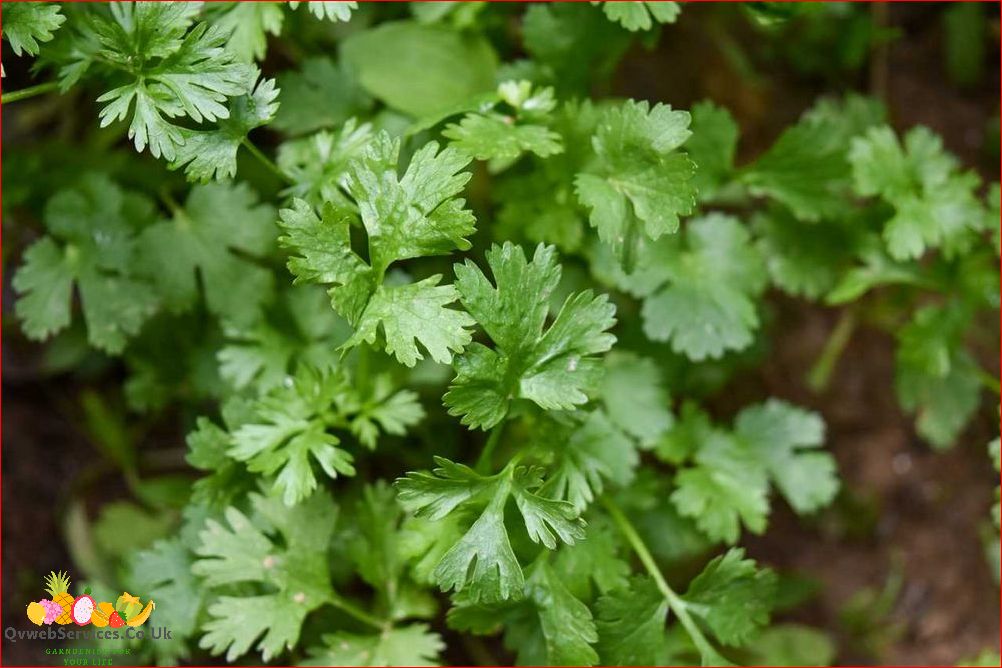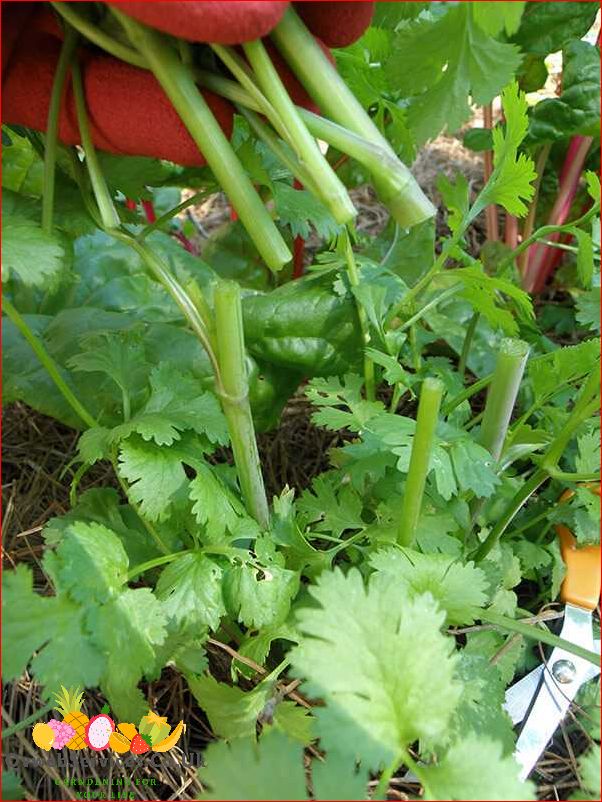How to Trim Cilantro Plant for Continuous Growth

Cilantro, also known as coriander, is a versatile herb that adds a fresh and vibrant flavor to many dishes. Whether you’re using it in salsa, guacamole, or curry, having a continuous supply of cilantro is a must for any herb lover. One way to ensure a steady harvest is by properly cutting the cilantro plant.
Step 1: Choose the Right Time
Before you start cutting your cilantro plant, it’s important to choose the right time. Cilantro is best harvested when it reaches a height of about 6-8 inches. At this stage, the leaves are flavorful and tender, making them perfect for culinary use. Avoid waiting too long to harvest, as the plant may start to bolt and the leaves will become bitter.
Step 2: Cut Above the Nodes
When cutting cilantro, it’s essential to cut above the nodes. Nodes are the points on the stem where the leaves emerge. By cutting above the nodes, you encourage the plant to produce new growth from these points. Use a sharp pair of scissors or pruning shears to make a clean cut just above a node. Avoid cutting too close to the base of the plant, as this can damage the stem and hinder regrowth.
Step 3: Leave Some Leaves Behind
While it may be tempting to cut off all the leaves at once, it’s important to leave some leaves behind. This ensures that the plant can continue to photosynthesize and produce energy for new growth. Aim to leave at least 1/3 of the leaves on the plant when cutting. This will allow the cilantro plant to recover quickly and continue to thrive.
Step 4: Regularly Harvest
To promote continuous growth, it’s crucial to regularly harvest your cilantro plant. As the plant grows, continue to cut above the nodes, leaving some leaves behind each time. This will encourage the plant to produce new stems and leaves, resulting in a bushier and more productive plant. By regularly harvesting your cilantro, you can enjoy a constant supply of fresh herbs throughout the growing season.
By following these simple steps, you can ensure a continuous supply of cilantro for all your culinary needs. Happy cutting!
Definition Cilantro Plant Growth Cycle
The cilantro plant, also known as coriander or Chinese parsley, is a fast-growing annual herb that belongs to the Apiaceae family. It is native to regions in southern Europe, northern Africa, and southwestern Asia. The plant has a distinctive aroma and flavor, with its leaves and stems commonly used as a culinary herb in various cuisines.
The growth cycle of a cilantro plant can be divided into several stages:
- Germination: The first stage of the growth cycle is germination, where the cilantro seeds sprout and develop into seedlings. This process usually takes around 7 to 10 days, depending on the environmental conditions.
- Seedling stage: Once the seeds have germinated, the cilantro plant enters the seedling stage. During this stage, the plant develops its first true leaves and starts to establish its root system. It is important to provide adequate water and sunlight to ensure proper growth.
- Vegetative stage: After the seedling stage, the cilantro plant enters the vegetative stage. During this stage, the plant grows rapidly, producing more leaves and stems. It requires regular watering and fertilization to support its growth.
- Flowering stage: As the cilantro plant matures, it enters the flowering stage. During this stage, the plant produces small white or pink flowers, which eventually develop into seeds. At this point, the flavor of the leaves may become more bitter.
- Seed production: Once the flowers have bloomed, the cilantro plant focuses its energy on seed production. The flowers turn into small green seeds, known as coriander seeds, which can be harvested and used as a spice.
- Senescence: After the seed production stage, the cilantro plant starts to senesce and decline. The leaves and stems may turn yellow and dry out. At this point, it is recommended to remove the plant and replant new cilantro seeds for continuous growth.
Understanding the growth cycle of a cilantro plant is essential for proper care and cultivation. By providing the right conditions and knowing when to harvest, you can promote continuous growth and enjoy fresh cilantro throughout the growing season.
Proper Cutting Techniques for Cilantro Plants

Proper cutting techniques are essential for promoting continuous growth in cilantro plants. By following these guidelines, you can ensure that your cilantro plants stay healthy and productive.
1. Timing: It is important to wait until your cilantro plants have reached a height of at least 6 inches before you start cutting. This allows the plants to establish a strong root system and ensures that they can handle the stress of being trimmed.
2. Cutting the Leaves: When cutting cilantro leaves, it is best to use a sharp pair of scissors or pruning shears. Start by cutting the outermost leaves first, leaving the inner leaves intact. This allows the plant to continue growing and producing new leaves.
3. Harvesting the Stems: If you want to harvest the stems of the cilantro plant, it is important to do so carefully. Cut the stems close to the base of the plant, making sure not to damage the main stem or any new growth. This will encourage the plant to produce more stems and prolong its overall lifespan.
4. Avoid Over-Cutting: While it may be tempting to harvest all the leaves and stems at once, it is important to avoid over-cutting. Removing too much foliage can weaken the plant and prevent it from regrowing. Instead, aim to remove no more than one-third of the plant at a time.
5. Regular Pruning: To promote continuous growth, it is recommended to prune your cilantro plants regularly. This involves removing any yellow or wilted leaves, as well as any flowers that may appear. Regular pruning helps to redirect the plant’s energy towards producing new leaves and stems.
By following these proper cutting techniques, you can ensure that your cilantro plants remain healthy and productive. Remember to always use sharp tools, avoid over-cutting, and prune regularly to encourage continuous growth.
Care and Maintenance of Cilantro Plants
Proper care and maintenance are essential for ensuring the healthy growth of cilantro plants. By following these tips, you can enjoy a continuous supply of fresh cilantro leaves for your culinary needs.
- Location: Cilantro plants thrive in full sun or partial shade. Choose a location that receives at least 6 hours of sunlight per day.
- Soil: Cilantro prefers well-draining soil with a pH level between 6.2 and 6.8. Amend the soil with organic matter, such as compost, to improve its fertility and drainage.
- Watering: Keep the soil consistently moist but not waterlogged. Water the plants deeply once or twice a week, depending on the weather conditions. Avoid overwatering, as it can lead to root rot.
- Fertilization: Apply a balanced fertilizer, such as a 10-10-10 formula, every 4-6 weeks during the growing season. Follow the instructions on the fertilizer package for proper application rates.
- Pruning: Regularly prune the cilantro plants to encourage bushier growth and prevent them from bolting. Pinch off the top 1/3 of the plant when it reaches a height of 6-8 inches. This will promote the production of new leaves.
- Pest and Disease Control: Monitor the plants for common pests, such as aphids and spider mites. If necessary, use organic insecticides or insecticidal soaps to control the infestation. Also, be vigilant for signs of fungal diseases, such as powdery mildew, and treat them promptly with appropriate fungicides.
- Harvesting: Harvest the cilantro leaves when they are young and tender. Use a pair of sharp scissors or pruning shears to cut the outer leaves, leaving the inner ones to continue growing. Regular harvesting will encourage the plant to produce more leaves.
By providing the right conditions and giving proper care, you can ensure the health and continuous growth of your cilantro plants. Enjoy the fresh and aromatic flavor of homegrown cilantro in your favorite dishes!
Growing Cilantro from Seeds
One of the most popular herbs used in cooking, cilantro adds a fresh and vibrant flavor to dishes. Growing cilantro from seeds is a simple and rewarding process that allows you to have a continuous supply of this flavorful herb.
Choosing the Right Seeds
When selecting cilantro seeds, it is important to choose high-quality seeds from a reputable source. Look for seeds that are fresh and have a high germination rate. Organic seeds are also a good option if you prefer to grow your cilantro organically.
Preparing the Soil
Cilantro grows best in well-draining soil that is rich in organic matter. Before planting the seeds, prepare the soil by removing any weeds and loosening it with a garden fork or tiller. Incorporate compost or well-rotted manure to improve the soil’s fertility.
Planting the Seeds
Sow the cilantro seeds directly into the prepared soil, spacing them about 1 inch apart. Cover the seeds with a thin layer of soil, about 1/4 inch deep. Water the soil gently to keep it moist but not waterlogged.
Caring for Cilantro Seedlings
Once the cilantro seedlings emerge, thin them out to allow proper airflow and prevent overcrowding. Water the seedlings regularly, keeping the soil consistently moist. However, be careful not to overwater, as cilantro is prone to root rot.
Harvesting Cilantro
Cilantro leaves can be harvested when they are about 4 to 6 inches long. Use a pair of clean scissors or garden shears to cut the leaves just above the soil level. Regularly harvesting the leaves will promote continuous growth and prevent the plant from bolting.
| Planting Depth | Spacing | Germination Time | Harvest Time |
|---|---|---|---|
| 1/4 inch | 1 inch apart | 7-14 days | 4-6 weeks after planting |
By following these simple steps, you can successfully grow cilantro from seeds and enjoy a continuous supply of this flavorful herb in your cooking.
Pruning and Controlling Cilantro Growth
Pruning is an important step in promoting continuous growth and maintaining the health of your cilantro plant. By regularly pruning your cilantro, you can prevent it from bolting and ensure a steady supply of fresh leaves.
When to Prune
It is best to start pruning your cilantro when it reaches a height of about 6 inches. This is usually around 3 to 4 weeks after planting. Pruning at this stage will encourage the plant to branch out and produce more foliage.
Additionally, if you notice any yellowing or wilting leaves, it is a good idea to prune them off. This will help redirect the plant’s energy towards healthy growth.
How to Prune
To prune your cilantro plant, simply use a pair of clean, sharp scissors or pruning shears. Start by cutting off the top 1/3 of the plant, just above a leaf node. This will stimulate new growth and prevent the plant from becoming too leggy.
When pruning, make sure to leave at least 2 to 3 inches of foliage on the plant. This will allow it to continue photosynthesis and produce energy for growth.
It is also important to remove any flowers that may appear on the plant. Cilantro plants tend to bolt and produce flowers quickly, which can lead to a decline in leaf production. By removing the flowers, you can prolong the plant’s leafy stage.
Controlling Cilantro Growth
In addition to pruning, there are other methods you can use to control the growth of your cilantro plant.
| Method | Description |
|---|---|
| Thinning | Thinning involves removing some of the cilantro plants to create more space for the remaining ones to grow. This can help prevent overcrowding and competition for resources. |
| Harvesting | Regularly harvesting the outer leaves of the cilantro plant can help control its growth. By removing the older leaves, you can encourage the plant to produce new ones. |
| Spacing | When planting cilantro, make sure to space the seeds or seedlings at least 6 inches apart. This will give each plant enough room to grow and prevent overcrowding. |
By implementing these pruning and growth control techniques, you can ensure a continuous supply of fresh cilantro leaves for your culinary needs.
Harvesting Cilantro Leaves for Culinary Use
When it comes to using cilantro in your culinary creations, knowing how to properly harvest the leaves is essential. Cilantro leaves are packed with flavor and can add a fresh and vibrant taste to a variety of dishes, from salads and salsas to soups and curries. Here are some tips on how to harvest cilantro leaves for culinary use.
Timing is Key
Timing is crucial when it comes to harvesting cilantro leaves. You want to wait until the plant has grown to a height of about 6 inches before you start harvesting. This ensures that the leaves have reached their maximum flavor potential.
Leaf Selection
When selecting leaves to harvest, look for ones that are dark green and fully grown. Avoid leaves that are yellowing or wilting, as they may not have the best flavor. It’s also a good idea to harvest leaves from the outer parts of the plant, as this encourages new growth from the center.
Using a pair of clean scissors or garden shears, cut the leaves off at the base of the stem. Be sure to leave at least 1 inch of stem attached to the plant, as this will allow for regrowth. Avoid cutting off more than one-third of the plant’s leaves at a time, as this can stunt its growth.
Once you’ve harvested the cilantro leaves, give them a thorough rinse under cold water to remove any dirt or debris. Pat them dry with a clean towel or paper towel before using them in your recipes.
Remember, cilantro leaves are best used fresh, so try to use them as soon as possible after harvesting. If you have more cilantro leaves than you can use at once, you can store them in the refrigerator. Place them in a plastic bag or container lined with a damp paper towel to help keep them fresh for longer.
Now that you know how to harvest cilantro leaves for culinary use, you can enjoy the fresh and vibrant flavor of this versatile herb in your favorite dishes. Happy harvesting!
Video:How to Trim Cilantro Plant for Continuous Growth
CILANTRO: Still Full Of Flavor Even AFTER It Bolts. How To Keep Picking & Using It ALL Season Long
As Stephanie C. Phillips, I am the voice and green thumb behind QvWebServices.co.uk. My passion for gardening and sharing my knowledge with others has led me to create a space where fellow gardening enthusiasts can find practical advice and inspiration.
From the sun-soaked fields of Texas to the cozy balconies of city dwellers, I strive to guide you through the nuances of growing your own food and beautifying your surroundings with plants. My articles are a reflection of my dedication to the art of gardening, and I hope they encourage you to get your hands dirty and enjoy the rewards of nurturing life from the soil.
Join me on this verdant journey to cultivate not just gardens, but a sense of community and connection to the earth.

